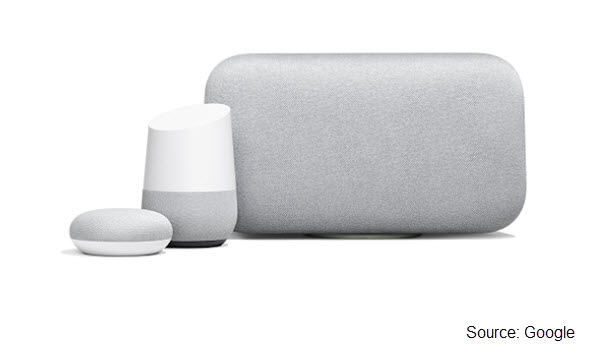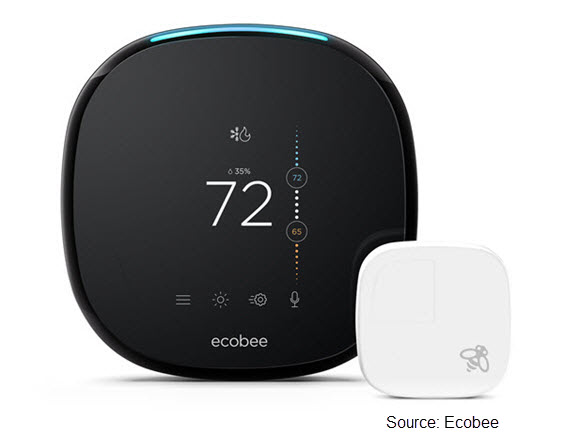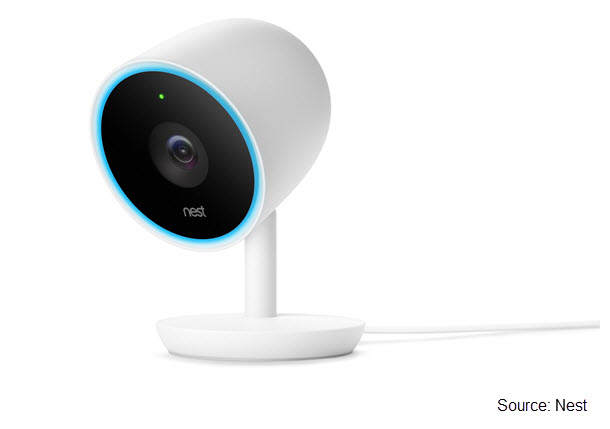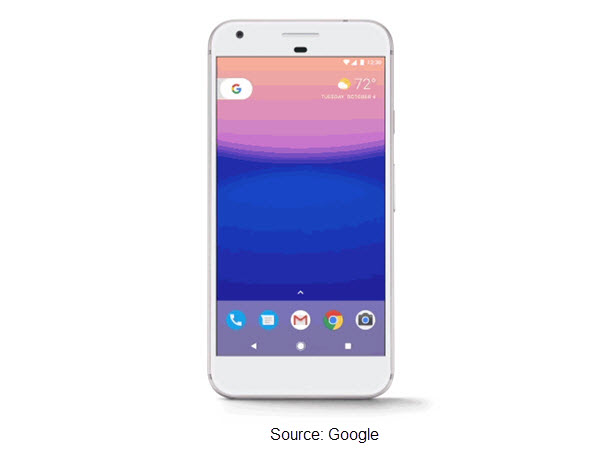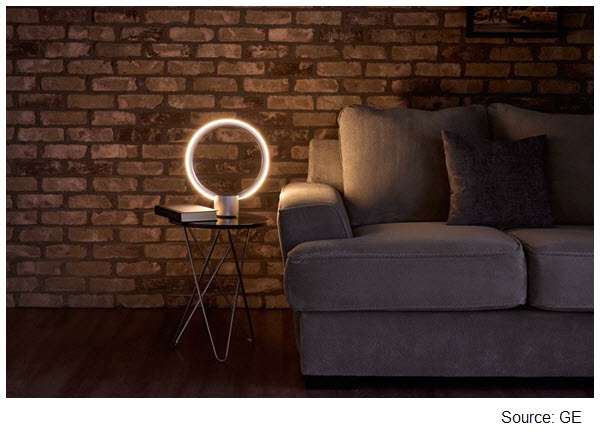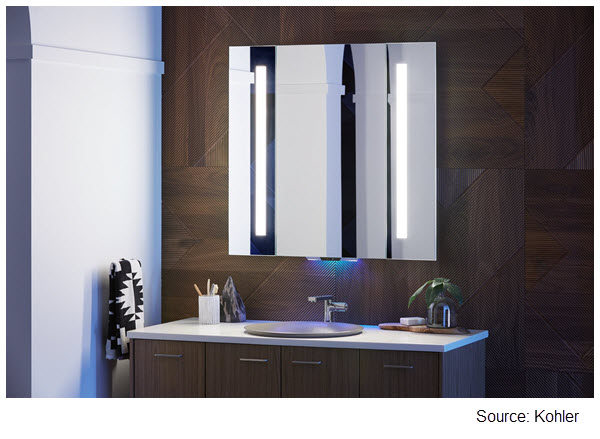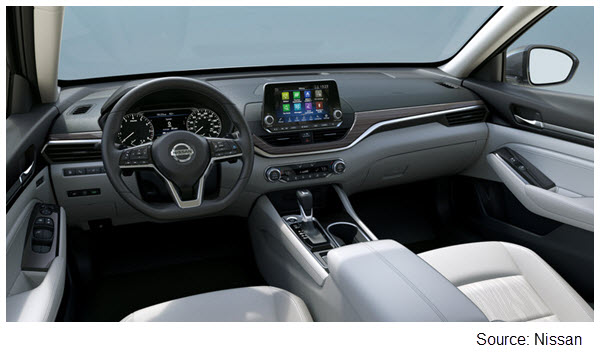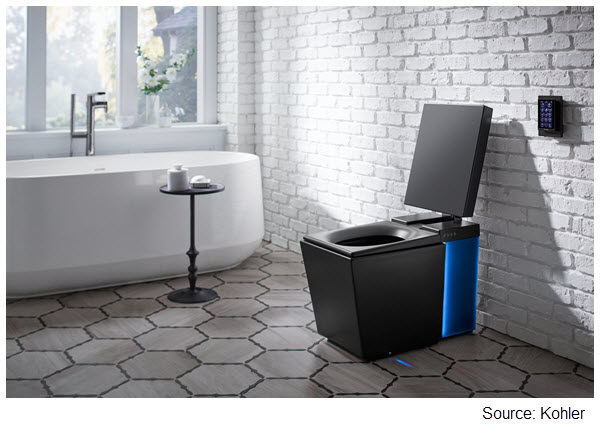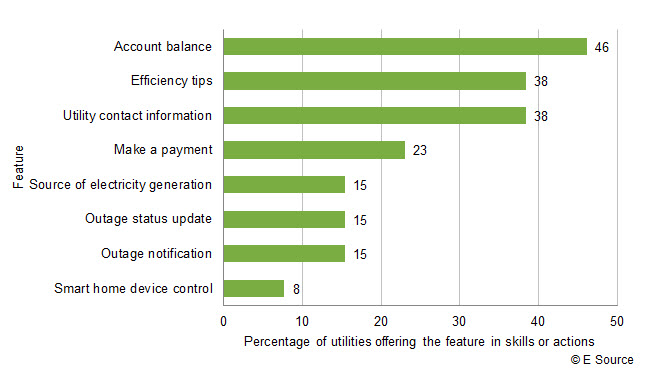When Amazon released the first voice-controlled smart speaker—the Amazon Echo—to a limited number of customers in 2014, few could have predicted how popular it would become. Device sales have skyrocketed, with shipments now in the tens of millions per year, and it has spawned competing devices from companies like Google and Apple. Because virtual assistant platforms are so popular, they’re quickly becoming a key interface for a range of smart home systems and devices. Market research from the Residential Utility Customer Survey and ethnographic research completed for E Design 2020 reveal that customers across the US are familiar with these devices, have had positive experiences with them, and even want to interact with their utilities via this channel. Additionally, new data from manufacturer Ecobee suggests that even with devices like thermostats, customers are using voice-control functionality in unique, creative, and unexpected ways.
For utilities, voice-control devices are worth paying attention to because of the smart home interconnectivity they enable as well as the unique marketing and communications opportunities they provide. For example, these devices could help you:
- Share relevant information with customers
- Offer automation across connected devices to improve efficiency or manage demand
- Promote trade allies
- Allow customers to pay bills
- Enroll customers in utility programs
- Help reduce call volumes in contact centers
Although relatively few utilities have taken advantage of voice-control technology to date, we expect to see more engagement going forward given the unique and exciting opportunities it offers.
The time to engage is now
Sales of stand-alone smart speakers such as the Amazon Echo and Google Home are exploding. According to Internet of Things market research and consulting firm Parks Associates, 55% of US broadband households will likely have a smart speaker with a voice-based personal assistant by 2021. For utilities, these devices represent an important new way to engage with customers, empower them with relevant information, and help them create smart home systems that can successfully manage their energy use. Particularly in deregulated markets, utilities that quickly and effectively leverage virtual assistants will create a unique competitive differentiator that promotes a positive brand image and directly helps customers.
E Source research shows that 60% of smart speaker owners said they’re “probably” or “definitely” interested in a utility app that makes use of voice-activated skills.
The E Source report “Which customers are interested in smart speakers, and how do you reach them?” based on data from the Residential Utility Customer Survey, highlights how much of the market has already adopted virtual assistants and identifies opportunities smart speakers present for utilities. Of particular interest, 27% of US respondents said they currently own a smart speaker, and 60% of smart speaker owners said they’re “probably” or “definitely” interested in a utility app that makes use of voice-activated skills.
According to the market study Smart Audio Report, Spring 2018 (PDF) from National Public Radio (NPR) and Edison Research, ownership of smart speakers is fairly evenly distributed across genders and age groups (suggesting a wide potential audience). The researchers found that 32% of smart speaker owners have controlled household devices with a smart speaker in the past week (primarily lighting, thermostats, or appliances) and that 59% have encouraged a friend to get a smart speaker. Moreover, 44% of the survey respondents indicated that time spent with smart speakers replaced time previously spent with radio, and 35% reported offsetting time spent with their smartphones—two major channels utilities rely on for communications and marketing.
These statistics suggest that virtual assistants are gaining impressive market share and becoming an essential part of customers’ lives, and that they’re likely to influence customers’ expectations about how they get information from their utility. And although smart speakers are the most prominent smart home devices using virtual assistants, they aren’t alone: Many smart home manufacturers are beginning to incorporate these interfaces directly into their products (Figure 1). In terms of energy management, Ecobee was one of the first manufacturers to add a virtual assistant into its products with the introduction of the Ecobee4 smart thermostat (which features Amazon’s Alexa), and other smart devices are now following suit. For example, Google Assistant is now included on more than 500 million devices (including smartphones) across 450 brands. Still other voice control–capable devices are designed to work with smart speakers even if the devices don’t include a virtual assistant interface.
Figure 1: A handful of devices with built-in virtual assistants
At present, Amazon and Google dominate the smart home virtual assistant market and provide open-platform systems that make them well suited to utility needs. Alexa and the Google Assistant can each control more than 5,000 smart home devices from thousands of brands, and the number of supported languages and features offered is continually expanding. Other platforms and virtual assistants also exist—including Apple’s Siri, Microsoft’s Cortana, and IBM’s Watson—but these currently lack the level of home penetration, support for device interconnectivity, and flexibility for third parties that the Amazon and Google platforms offer.
The good news is that creating a skill or action isn’t difficult, and there are resources available to help you take the next step.
To get the most out of virtual assistants, you’ll need to build skills (for Alexa) or actions (for the Google Assistant). The good news is that creating a skill or action isn’t difficult, and there are resources available to help you take the next step. Foremost of these are Amazon’s guide to Designing for Voice and Google’s overview of Actions on Google, both of which describe the process of designing for these platforms and offer specific advice to help you succeed. And while many utilities will be able to build skills or actions in-house, there are also hundreds of third-party development agencies that can help.
What should a utility skill or action do?
To date, only a dozen utilities in the US and Canada have created skills or actions, and most of the functionality relates to customer education, including account balance and generic energy-efficiency tips (Figure 2).
Figure 2: What features do utility skills and actions currently provide?
These features are a step in the right direction, but utilities have only scratched the surface of what’s possible. We’ve compiled a handful of ideas for functionality that expand on what utilities’ current skills or actions provide and may help you better achieve your utility’s goals—from engaging customers around demand-side management (DSM) programs or new rate structures to providing a better customer experience and reducing call volumes.
Share information and connect customers with utility programs. Because smart speakers are inherently responsive devices (they wait until you talk to them, rather than proactively talking to you), they aren’t as suited to traditional marketing strategies as other channels. One way to promote your utility offerings is to allow customers to ask about your current rebates, efficiency programs, or other services through a skill or action. But a potentially more effective approach is to fold utility information into the daily tasks that customers perform with virtual assistants to make the material more relevant and appealing and to create a deeper customer connection.Fold utility information into the daily tasks that customers perform with virtual assistants to make the material more relevant and appealing and to create a deeper customer connection. For example, you could create snippets of information to include in customers’ daily news summary or “flash briefings.” This might be a notification that the customer is on track to have a particularly high or low energy bill this month, seasonal efficiency tips, a short explanation of the effect of current weather on the customer’s bill, or context-relevant information on efficiency or demand-response (DR) programs. Additionally, by allowing customers to enroll in DSM and DR programs directly from their smart speaker, you could streamline the process for customers (particularly if the smart speaker is already connected to a smart thermostat or other smart device), while potentially reducing the cost of acquisition for programs. Similarly, promoting revenue-generating services directly related to customers’ interests and activity could help increase uptake and make it easier for customers to participate.
Help customers understand time-variant rates and energy generation. As utilities increasingly shift toward providing dynamic and time-of-use (TOU) rate structures, it’s more important than ever to ensure that customers feel supported and empowered to make the best decisions for their energy needs. Beyond online portals and mobile apps, virtual assistants can provide another way to educate customers about how their rate structure affects their bill and what they can do to take charge of their energy use. This can help them make effective choices and reduce dissatisfaction with rate changes. Additionally, ethnographic research performed for the E Source E Design 2020 project suggests that utility customers are increasingly looking for clean, local energy solutions, opening up the possibility of sharing real-time information on generation sources to help customers better understand where the energy they use comes from.
Help customers control smart devices. Smart speakers offer an intuitive user interface and are compatible with an array of connected home products. As a result, there’s potential to enable customers to set up energy-efficient home modes (adjusting settings across multiple devices to promote efficiency), to help customers turn off or adjust device settings during DR events, and to dynamically adjust power draw in response to TOU rates. Although some customers—particularly early adopters—will want to learn all the intricacies of their connected home system and tinker with it, these preset modes could be especially appealing to users who just want lower energy bills or to be more eco-friendly.
Virtual assistants can help promote your trade allies and make it easier for customers to take advantage of your efficiency offerings.
Walk customers through a home energy audit. Skills and actions could be well suited to guiding customers through their home in a simple do-it-yourself energy audit. By taking a step-by-step approach, asking simple questions, and providing immediate feedback, this functionality could help customers learn about some of the biggest efficiency opportunities in their home, while also promoting available utility DSM incentives.
Promote trade allies. By allowing customers to ask for suggestions on trusted local contractors for energy-efficient home upgrades or maintenance, you can promote your trade allies and make it easier for customers to take advantage of your efficiency offerings. Additionally, tying in smart devices (like smart thermostats) that can facilitate remote diagnostics could make this approach even more effective. For example, a virtual assistant could alert customers to failing equipment and provide suggestions for local contractors who can fix the problem and information on available utility rebates.
Expand educational campaigns. According to NPR’s Spring 2018 Smart Audio Report, children are using smart speakers in 73% of homes that have these devices. Among other things, they’re using smart speakers to answer questions, help with homework, read short stories and audiobooks, and play games. Many utilities offer educational resources to children and educators via online tools, lesson plans, games, and coloring books, so smart speakers could provide a fun and interactive new channel to teach kids about safety and energy efficiency.
By diverting even a small percentage of customer care calls away from the call center, utility skills or actions could quickly pay for themselves and help improve the bottom line.
Improve the customer experience and reduce call volumes. Unlike many utility interactive voice response systems, websites, and even mobile apps, smart speakers and virtual assistants are hands-free, intuitive, and simple to use. As a result, smart speakers are an ideal platform for communicating with customers—particularly around frequently requested information—and they could reduce the volume of calls to a utility’s contact center. By diverting even a small percentage of customer care calls away from the call center, utility skills or actions could quickly pay for themselves and help improve the bottom line. And because customers are excited about and engaged with this channel, smart speakers can also promote a positive utility brand image.
What we’ve learned
It’s early days for utility skills and actions, but we’ve already learned several lessons from early-adopter utilities, customer reviews, and data from companies such as Google and Ecobee.
Users want the virtual assistant to tie the advice back to their utility account so they’ll be assured that the suggestions are relevant for them and have some idea of how much money or energy they’ll save.
Customers prefer specific efficiency tips to generic ones. In reading customer reviews on Amazon, we see that users want customized energy-efficiency tips from their utility that will help them save money. Ideally, users want the virtual assistant to tie the advice back to their utility account so they’ll be assured that the suggestions are relevant for them and have some idea of how much money or energy they’ll save. For example, one customer complained, “Energy tips are generic … What’s the point of the [skill] if it does not link into my [utility] account?” We recommend providing tailored energy-efficiency tips through a skill or action based on customers’ unique home characteristics and energy consumption patterns.
Customers want the ability to pay their power bill. In addition to checking their account balance, users have expressed a desire to pay their bill via a utility skill or action. Only providing balance information—and then forcing customers to go to a different platform to pay their bill—can result in negative customer experiences and strong pushback. TXU Energy’s skill, which offers both of these features, has received positive feedback from customers. Comments include: “Love it love it love it. Love it now i dont have to get out my laptop or call to make a payment love it” and “Works like a charm! … Quick setup and I’m able to check my balance, make a payment, etc. great skill!”
Carefully test skills and actions before releasing them and vet supported devices to ensure that they deliver a positive customer experience before pushing out functionality via a skill or action.
Reliability and robustness are critical. Customers expect robust and trustworthy features from third-party skills or actions, and they’ll get frustrated if the feature doesn’t work smoothly or as expected. We recommend carefully testing skills and actions before releasing them and vetting supported devices to ensure that they can deliver a positive customer experience before pushing out functionality via a skill or action.
Customers use different interfaces for different purposes. Manufacturers such as Ecobee are finding that customer interactions for virtual assistant–enabled smart home products like smart thermostats aren’t limited to device control. In fact, customers like to play music, control other smart home devices, ask trivia questions, and perform other activities not immediately associated with a device like a thermostat. Inside the home, voice control offers an easy and streamlined smart home control interface, but web portals and mobile apps can be especially helpful when customers want to control their devices remotely.
Customers need more education about outage notifications. Many utility skills or actions allow customers to report outages or get outage notifications. Because smart speakers (and other plugged-in smart devices with built-in virtual assistants) will turn off during outages, customers don’t understand the benefits of this feature. As one review says, “Let me hook my generator up to my [smart speaker], router, and cable modem so I can report an outage!!! Haha.” For the most part, this feature is intended for customers who use virtual assistants on their smartphones (which are likely to be functional during an outage), and you should clearly explain this in the description of your skill or action to avoid confusion and negative experiences.
What’s next?
There are strong indications that virtual assistants aren’t just a passing fad and that they’ll flourish in the coming years. For example, major electronics manufacturers seem to be in it for the long run. Google has repeatedly expressed its confidence in so-called “ambient computing” as the future of search and digital interaction. Amazon is working directly with new-home builders across the country to integrate Alexa into homes, making it a part of future occupants’ lives from day one. And other smart device manufacturers are incorporating virtual assistants into their new products (for example, the 2018 Consumer Electronics Show—which is a good representation of industry trends—was inundated by such devices).
As skills and actions become standard ways to interact with companies, customers will expect their utilities to offer this functionality.
As skills and actions become standard ways to interact with companies, customers will expect their utilities to offer this functionality. Utilities that stay on the leading edge of this trend have the opportunity to demonstrate leadership, innovation, and care for their customers. By embracing virtual assistants, you can help temper the effects of a rapidly changing DSM landscape—one in which increased efficiency standards and adoption of efficient equipment are making it difficult for utilities to meet their efficiency goals, and where demand management is becoming more important than ever. Virtual assistants can also mitigate the risk of third-party companies coming between you and your customers, boost engagement, and provide more-effective customer support. We expect that virtual assistants will have a vital role to play in the emerging and evolving utility business model.
Acknowledgments
We would like to recognize and thank everyone who contributed to this report by providing external review, offering input, and sharing data. In particular, we would like to thank Sarah Colvin at Ecobee, Brian Kirchman at ComEd, and staff from Google and Amazon.


